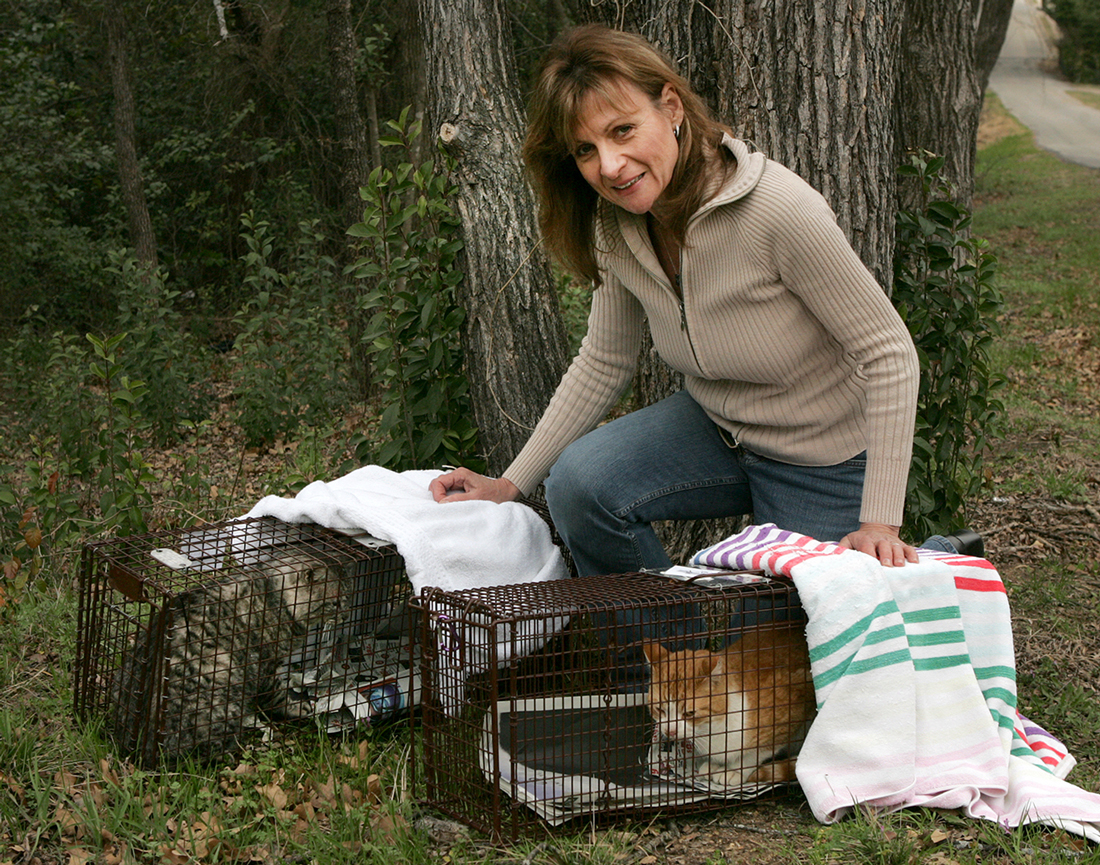Connie Stout is an animal right activist, but she didn’t plan on becoming the local spokesperson for a feral cat program known as trap-neuter-release. However, that’s the role the Bedford resident has played in her town for the last few years — all thanks to one mama cat and her kittens.
The program is gaining popularity around the country as an alternative to euthanizing animals. The idea is that if feral cats are trapped, neutered, and released again, the effect over time will be to reduce the cat populations. Supporters say it also eventually reduces public expenditures, whereas simply killing feral cats is an endless process. Although it has been adopted by many North Texas towns and cities, the idea has hit a roadblock in Bedford.
At a Jan. 28 Bedford city council meeting, Stout, who also serves on the city’s animal shelter advisory board, and her colleagues gave a presentation outlining benefits of the program. Council members made encouraging comments.
To the surprise of Stout and other advisory board members, the council, at the following Feb. 11 meeting, voted 4 to 3 against the implementation of trap-neuter-release. In the intervening weeks, residents and others had raised questions about the program. Even the police chief got into the debate, with a seven-page list of his department’s concerns.
Residents, police, and others are worried about liability issues, the threat of disease from handling the cats, and how effective the program would be.
For Stout and her supporters, the defeat effectively means the continued killings of hundreds of healthy cats each year without addressing the underlying problems.
Stout sees the problem firsthand in her volunteer work at the city’s animal shelter.
“Each spring we’re inundated with kittens,” she said. “The more time I spent at the shelter, the more I realized we needed … a trap-neuter-release program in Bedford.”
City council member Michael Boyter said none of his council colleagues wants to see animals put down unnecessarily. “Sometimes the wheels of government move a little slower than people would like,” he said.
Boyter joined Mayor Jim Griffin and council members Dr. Roy Turner and Jim Davidson in voting against the trap-and-release recommendations. Boyter said his vote came down to details.
“It was the detailed instructional part that I didn’t hear,” he said. “I understand that this issue is very emotional, but we needed a structured plan on who does what, an A to Z type thing. There is a [component] of someone taking these cats to the shelters. Do residents do that? Who’s responsible? And then there are the liability issues if a resident is injured during the process.”
Bedford and many cities in Texas are commonly referred to as “trap-and-kill” areas, because once a feral cat is brought to a shelter, it must be euthanized. Dr. Becky Epps, a North Texas veterinarian who makes house calls, said adoption isn’t possible for most feral cats, leaving euthanasia as the only viable option.
“These cats are truly wild,” she said. “They were born in the wild and are not adoption candidates. You go toward them, and they’ll run.”
According to Liz Holtz, staff attorney for Alley Cats Allies, there has been a tenfold increase in trap-neuter-release programs in the past 10 years around the country. Nationwide, 430 municipalities now include some form of that policy. Alley Cat Allies is a national advocacy organization dedicated to the protection and humane treatment of cats.
The growth has been even faster in Texas. “We’ve seen a thirtyfold increase in communities supporting trap-neuter-return in Texas between 2003 and 2013,” she said.
Holtz said it comes down to saving money.
“When I speak about this program, I make sure to emphasize that it is about being fiscally responsible,” she said. “Cities like Bedford have been using trap-and-kill methods for years, and it’s not working.”
Stout’s efforts to reform Bedford’s policy on feral cats began six years ago when she found a mother and several kittens in her backyard. The cats were frightened of her, but she left food for them and eventually spent the time and money to have the cats fixed so they wouldn’t reproduce. Her reward, three years later, was a visit from an animal shelter official who told her that it was illegal to feed them.
If she had a problem with the laws, she should work to get them changed, the official told her. So she did. She talked to a local feral cat expert, then began volunteering at the city animal shelter. The experience confirmed her fears.
At the shelter, Stout met Epps, and together they worked on the city’s animal shelter advisory board. After the defeat of the trap-and-release proposal, Epps left the board in frustration, but Stout stayed on.
Turner, the city council member, said that Bedford “euthanizes fewer cats than any around here. I don’t see a problem. Irving euthanizes over 1,000 cats each year.”
“Some people are worried that if TNR passes, there will be an increase in the feral cat population,” said Sandra Bitz, board director at Panther City Feral Cat Coalition, a nonprofit group that works to humanely control the population of feral cats in Fort Worth. “Well, that’s not the proven case. The cats, their colonies, and the colony caregivers are already here. Killing thousands a year hasn’t solved the problem. Our aim is to reduce the population through TNR and [stop the] killing.”
Fort Worth adopted a catch-and-release policy in January 2013. The Texas Coalition for Animal Protection, a nonprofit that offers humane population programs for cats and dogs, partners with the city to implement the policy. When a feral cat is brought in, the shelter sends a picture of it to the nonprofit, which e-mails it to its more than 100 volunteers. The volunteer caretakers, who get training in how to safely trap and handle the cats, have three days to pick up the animal, get it neutered, and return it to its original colony. The volunteers cover the costs.
Animal Protection has neutered or spayed more than 170,000 dogs and cats in North Texas since the group started in 2002.
Stout says she is going to continue the fight to bring TNR to Bedford, but it’s probably time for someone else to lead the effort.
“I’m going to continue working on this, but in the background, educating the community,” she said. “I had no idea when I met that mother and her kittens six years ago that it was going to change my life.”
Fort Worth freelance writer Edward Brown can be reached at ejb0017@yahoo.com.













Great article! Thanks for giving press to this terribly important issue. TNR helps decrease the cat population and helps get those cats that are already in our communities the vaccinations they need – which improves safety for our citizens – so even people who don’t like cats have a reason to support TNR!
Thousands of innocent feral cats and kittens needlessly die at the hands of City of Bedford’s animal control officers year after year. Bedford’s decision to end discussion on this topic and to continue to MURDER animals and waste tax-payer dollars is a reason for residents or ‘potential NEW residents’ and business owners to reconsider residing in this archaic, non-progressive city. This city is an insult to the state of Texas and prefers to keep the ‘good ole boy’ offensive mentality and culture ‘alive and well’. I say this because I witnessed their refusal to even consider a new idea that would, not only save money, but SAVE LIVES. I attended the meetings and was repulsed and offended at how the citizens of Bedford (hundreds in attendance to support TNR), Dr. Becky Epps (who is the trained authority on the City of Bedford Animal Advisory Board), and Connie were, basically ignored and treated disrespectfully by a male dominated city council. Kudos to Connie and Dr. Epps for working tirelessly the past 3 years and attempting to save lives of innocents and for trying to save TAX-PAYER dollars…too bad it fell on deaf ears.
Isn’t Bedford the city that had to shut down their city library and recreation centers due to bad financial decisions a few years ago (even before the economy fell)?
Here’s the deal…Peckerwoods are going to be Peckerwoods…hammer-heads are going to be hammer-heads, Repugs are going to be Repugs….what else can they be?
I was shocked and horrified by the gross disrespect most of the council showed for the citizens and especially Dr, Epps. This citizen who has never voted in a Bedford city council meeting is on her way to vote for the only two council members who showed any interest in the TNR program and any respect for a very large group of committed citizens. Plus, they are not interested in saving the city funds. There should be no room for closed minds in our city leadership. Thank you for opening my eyes to your narrow-minded leadership. I will be working to open even more eyes!
Word of mouth goes a long way.. It was truly disheartening to read about the poor leadership choices of Bedford City Council – I am especially referring to the TNR program.
What will it be next?? Seriously??
I plan on spreading the word – as the pen is mightier than the sword.
I was proud to be a part of the city of Bedford. I cannot truly say that now.. How disappointing.